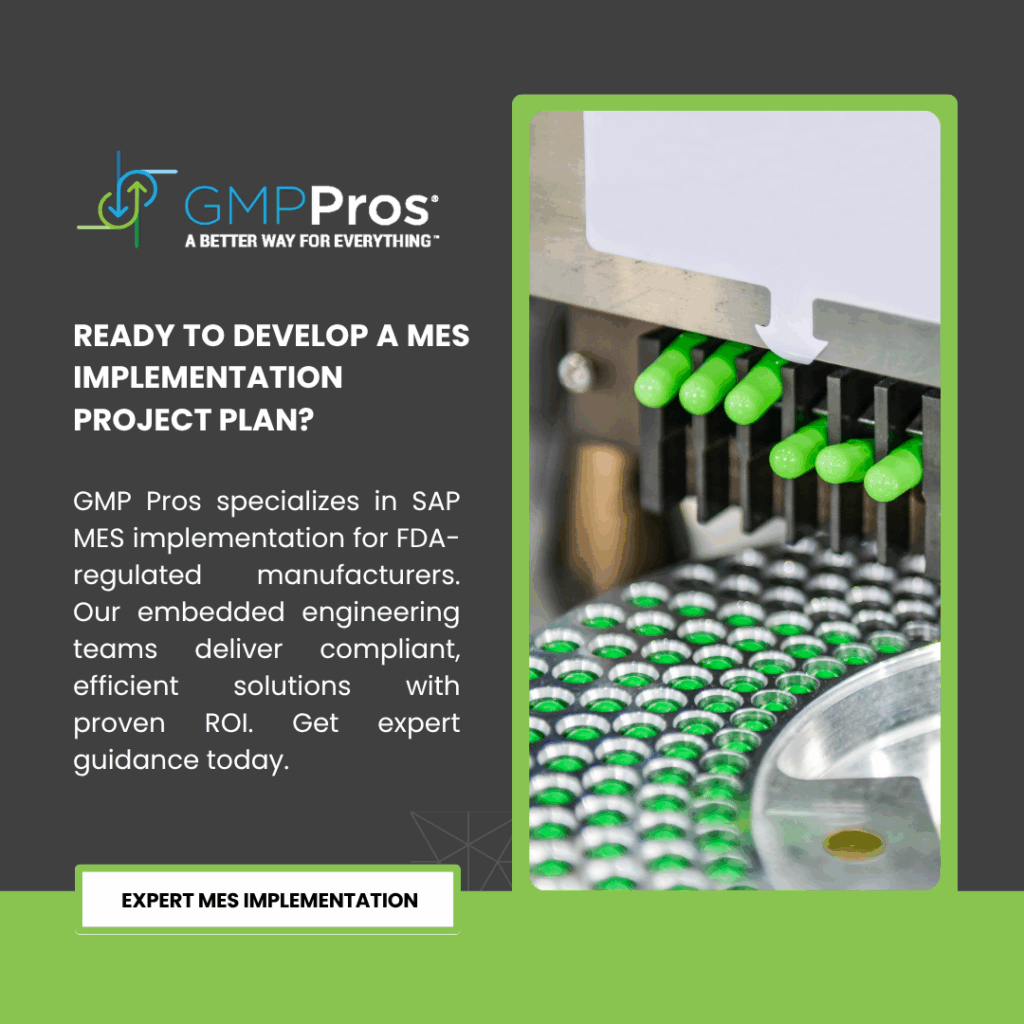Manufacturing execution systems have become the backbone of modern pharmaceutical production. Yet many FDA-regulated companies struggle with implementation failures that cost millions and delay critical product launches.
The difference between successful and failed MES deployments often comes down to one factor: comprehensive project planning. Companies that invest in detailed MES implementation project plans see dramatically better outcomes than those that rush into deployment.
This guide examines the essential components of successful MES implementation plans specifically for FDA-regulated manufacturing environments.
You’ll discover proven frameworks, regulatory compliance strategies, and real-world best practices that leading pharmaceutical and biologics companies use to achieve measurable results.
What Defines an Effective MES Implementation Project Plan
A Manufacturing Execution System (MES) implementation project plan serves as the strategic blueprint for deploying digital manufacturing solutions in FDA-regulated environments.
This comprehensive framework coordinates technical, regulatory, and operational requirements. It establishes clear milestones and accountability structures.
The complexity of pharmaceutical manufacturing environments demands meticulous planning approaches. These approaches address both immediate operational needs and long-term scalability requirements.
Modern MES implementation project plans incorporate risk-based approaches. These prioritize critical manufacturing processes while establishing fallback protocols for system disruptions.
This methodology has proven particularly effective in biologics manufacturing. Process variations can impact product quality and regulatory standing in these environments.
Strategic Planning Framework Components

Project Scope Definition and Boundaries
The foundation of any successful MES implementation project plan begins with precise scope definition. This definition must align with business objectives and regulatory requirements.
This phase establishes clear boundaries between in-scope and out-of-scope activities. It prevents scope creep that commonly derails manufacturing system deployments.
Effective scope definition addresses three primary dimensions. These include functional requirements, system integration points, and compliance boundaries. Functional requirements encompass manufacturing processes, quality control workflows, and reporting capabilities.
System integration points define how the MES will connect with existing enterprise systems. They also define connections with laboratory information management systems and regulatory reporting platforms.
Compliance boundaries establish which regulatory frameworks apply to specific manufacturing areas. They also determine how validation activities will be structured throughout the implementation.
This tri-dimensional approach provides project teams with clear decision-making criteria. Teams can use these criteria when scope questions arise during execution phases.
Resource Allocation and Team Structure
Resource allocation represents one of the most critical success factors in MES implementation project plans.
Pharmaceutical manufacturers typically allocate 60-70% of project resources to technical activities. They dedicate 20-25% to validation and compliance. The remaining 10-15% goes to change management and training.
The optimal team structure combines internal subject matter experts with external implementation specialists. External specialists bring cross-industry experience.
Internal resources provide deep knowledge of existing processes, regulatory history, and organizational culture.
| Role Category | Internal Resources | External Resources | Typical Allocation |
| Project Management | Site Project Manager | Implementation PM | 15-20% |
| Technical Leadership | IT Manager, Process Engineers | MES Architects | 25-30% |
| Validation & Compliance | Quality Assurance, Regulatory | Validation Specialists | 20-25% |
| Operations | Production Supervisors, Operators | Change Management | 15-20% |
| Subject Matter Experts | Process Owners | Industry Consultants | 15-20% |
Timeline Development and Critical Path Analysis
Timeline development for MES implementation project plans requires careful balance. Teams must balance aggressive deployment schedules with realistic resource constraints.
Industry data indicates that pharmaceutical MES implementations typically require 12-18 months for single-site deployments. Multi-site rollouts need 24-36 months.
Critical path analysis identifies activities that directly impact project completion dates. This allows teams to focus resources on bottleneck activities. Common critical path elements include system architecture decisions, data migration validation, and regulatory approval cycles.
Manufacturing process improvement initiatives often run parallel to MES implementation. This creates additional complexity in timeline coordination.
The most successful implementations establish buffer periods around critical path activities. This is particularly important for activities involving regulatory submissions or complex system integrations.
This approach has reduced schedule overruns by 30-40%. This compares favorably to aggressive timelines without contingency planning.
Technical Architecture and System Integration

Infrastructure Requirements and Scalability
Infrastructure planning represents a foundational element of successful MES implementation project plans. It directly impacts long-term system performance and reliability.
Modern pharmaceutical manufacturing environments require strong IT infrastructure. This infrastructure must support real-time data collection, complex calculations, and regulatory reporting demands.
Data Migration Strategy and Validation
Data migration represents one of the most complex aspects of MES implementation project plans. The migration strategy must preserve data integrity while transforming information into formats compatible with the new MES platform.
Historical batch records, quality data, and process parameters require careful mapping between old and new system structures.
This mapping process often reveals data quality issues in legacy systems that must be resolved before migration can proceed. Data quality monitoring protocols help identify and correct these issues systematically.
Migration validation uses a three-phase approach: data extraction verification, transformation validation, and loading confirmation. Each phase requires documented test procedures and acceptance criteria.
Risk Management and Mitigation Strategies

Technical Risk Assessment
The technical risk assessment forms the backbone of any MES implementation planning document. It poses potential failures affecting the normal manufacture or regulatory compliance.
Technical-risk categories include system-performance issues during peak manufacturing periods, integration failures disrupting data flow, cybersecurity vulnerabilities that could compromise manufacturing data, etc.
FMEAs typically constitute one of the more methodical approaches through which the risk assessment process evaluates potential points of failure through the entire system architecture.
This identifies critical failure modes that form the very basis of decisions on redundancy requirements and backup procedures.
Operational Risk Mitigation
Operational risks focus on how MES implementation might disrupt existing manufacturing processes or impact product quality. These risks require careful coordination between technical implementation teams and manufacturing operations personnel.
Production scheduling risks arise when MES implementation requires temporary shutdowns or reduced capacity during critical manufacturing periods.
The project plan must coordinate implementation activities with production schedules to minimize impact on product delivery commitments.
This coordination often drives phased implementation approaches that deploy MES functionality incrementally.
Training and change management risks relate to user adoption rates and operational proficiency with new system capabilities. Manufacturing efficiency depends heavily on user competency with MES functionality, making comprehensive training programs essential for project success.
Regulatory Risk Management
Regulatory risk management addresses potential compliance gaps that could result from MES implementation activities. These risks require deep knowledge of FDA expectations and industry best practices in manufacturing industry environments.
Validation timing risks occur when implementation schedules compress validation activities or overlap testing phases in ways that compromise thoroughness. The project plan must allocate sufficient time for comprehensive validation while meeting business timeline objectives.
Documentation risks arise when implementation teams fail to maintain adequate records of system configuration decisions, validation results, or change control activities.
These documentation gaps can create significant challenges during regulatory inspections or system maintenance activities. The MES implementation project plan must establish clear documentation standards and review procedures.
Implementation Phases and Milestone Management

Phase Gate Methodology
Phase gate methodology provides structured decision points throughout MES implementation project plans that enable project teams to assess progress, resolve issues, and make strategic adjustments before proceeding to subsequent phases.
The typical phase structure includes Project Initiation, Requirements Definition, System Design, Development and Configuration, Testing and Validation, and Go-Live Support.
Each phase concludes with formal gate reviews that evaluate deliverable quality, resource utilization, and risk status before authorizing continuation to the next phase.
Milestone Tracking and Performance Metrics
Milestone tracking provides visibility into project progress and enables early identification of potential delays or resource constraints. Effective MES implementation project plans establish milestones that correspond to meaningful project accomplishments rather than arbitrary calendar dates.
Key performance indicators (KPIs) for MES implementations typically include schedule adherence, budget variance, defect resolution rates, and validation completion percentages.
These metrics provide objective measures of project health that support data-driven decision-making throughout the implementation cycle.
| Milestone Category | Typical Metrics | Success Criteria |
| Schedule Performance | % Milestones On-Time | >85% adherence |
| Budget Management | Cost Variance % | <10% over budget |
| Quality Metrics | Defect Density | <2 defects per function point |
| Validation Progress | % Test Cases Passed | >95% first-pass rate |
| User Readiness | Training Completion % | 100% for go-live users |
Change Management and Communication Protocols
Change management protocols address how project modifications will be evaluated, approved, and communicated throughout the implementation team and stakeholder community.
These protocols become particularly important when implementation discoveries require adjustments to original project scope or approach.
Communication protocols establish regular reporting cadences, escalation procedures, and stakeholder engagement mechanisms.
The communication strategy must address both internal project team coordination and external stakeholder engagement. Internal communications focus on technical coordination, resource allocation, and issue resolution.
Go-Live Preparation and Support

Cutover Planning and Execution
Cutover planning addresses the transition from legacy systems to the new MES platform, including data migration execution, user training completion, and production operation resumption. This transition represents one of the highest-risk phases of MES implementation project plans.
The cutover approach typically employs either “big bang” transitions that switch all functionality simultaneously or phased approaches that gradually migrate manufacturing processes to the new system.
Phased approaches reduce risk but require temporary operation of parallel systems that increases complexity and resource requirements.
Cutover execution requires detailed runbooks that specify step-by-step procedures, timing requirements, rollback criteria, and communication protocols.
These runbooks must address both technical cutover activities and operational coordination requirements. Practice cutover exercises help identify potential issues and refine procedures before actual production transitions.
Post-Implementation Support Structure
Post-implementation support structure provides ongoing assistance to manufacturing personnel as they adapt to new MES capabilities and resolve operational questions. This support typically involves multiple tiers that address different types of issues and user needs.
| Support Tier | Responsibilities | Resource Type |
| Tier 1 | Routine user questions, basic troubleshooting, administrative tasks | Internal help desk |
| Tier 2 | Complex technical issues, system configuration, integration problems | Technical specialists |
| Tier 3 | System-level issues, enhancements, vendor escalations | Vendor resources, specialized expertise |
The support structure must also address how to measure data quality in the new system environment and establish monitoring protocols that identify potential issues before they impact manufacturing operations.
This proactive approach helps maintain system reliability and user confidence during the critical post-implementation period.
At GMP Pros, our experienced team specializes in MES implementation projects that deliver measurable results in FDA-regulated environments.
Our proven approach to project planning, validation, and support helps pharmaceutical and biologics manufacturers deploy MES solutions that improve manufacturing efficiency while maintaining regulatory compliance.
Contact our team to discuss how our methodologies can support your MES implementation objectives.
Conclusion and Next Steps
This guide covers all pertinent aspects of planning, including those related to ensuring regulatory compliance, technical architectural design decisions, risk management strategies, and post-implementation support structures.
The secret to a successful MES implementation is careful upfront planning to address deployment issues at present, with the operational issues in the foreseeable future.
Organizations that spend enough time planning their projects generally have much smoother implementations, user adoption rates, and long-term performance of their companies.
Modern MES implementation project plans strive to balance the aggressive deployment schedule with comprehensive validation requirements and have a clear focus on measurable business outcomes.
Such balancing can be achieved with implementation teams that have the experience in both technical capability and expectations from a regulatory point of view in pharmaceutical manufacturing environments.

Ready to develop a comprehensive MES implementation project plan for your manufacturing operations?
Contact GMP Pros to discuss how our proven planning methodologies and hands-on implementation expertise can help you achieve your digital manufacturing objectives while maintaining regulatory compliance and operational excellence.

